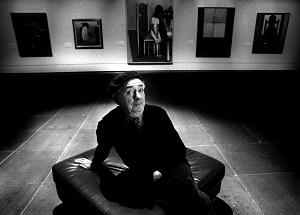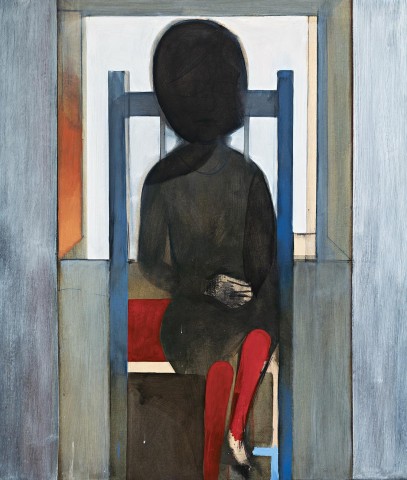WINDOW LIGHT, 1965
CHARLES BLACKMAN
oil and charcoal on paper on board
151.0 x 130.5 cm
signed lower right: Blackman
South Yarra Gallery, Melbourne
Mrs V. Kahlbetzer, Sydney
Christie’s, Melbourne, 27 April 1998, lot 70
Savill Galleries, Melbourne
Private collection
Sotheby's, Melbourne, 4 May 2004, lot 33
Company collection, Sydney
New Paintings, Charles Blackman, Skinner Galleries, Perth, February 1966, cat. 24
New Paintings, Charles Blackman, South Yarra Gallery, Melbourne, 29 March – 22 April 1966, cat. 11
Charles Blackman, Schoolgirls and Angels, National Gallery of Victoria, Melbourne, 18 May – 16 August 1993, and touring: Art Gallery of New South Wales, Sydney, 23 September – 21 November 1993; City Art Gallery, Brisbane, 7 December 1993 – 27 January 1994; Art Gallery of Western Australia, Perth, 16 February – 4 April 1994, cat. 76 (label attached verso)
Moore, F. St. J., Charles Blackman: Schoolgirls and Angels, National Gallery of Victoria, Melbourne, 1993, p. 91 (illus.)
Dickins, B., & McGregor, K., Charles Blackman, Macmillan, Melbourne, 2010, p. 103 (illus.)
Window Shadow, 1965, oil on canvas, 183.4 × 142.6 cm, in the collection of the National Gallery of Victoria, Melbourne
Two months after his sell-out solo exhibition at the Johnstone Gallery, Brisbane, in June 1960, Charles Blackman won the prestigious Helena Rubinstein Travelling Scholarship and by February the following year he and his family had relocated to London. Initially settling into a house in Highgate where he transformed the mezzanine into a studio, Blackman frequented the city’s galleries viewing the work of British and European artists he had previously only seen in books, as well as visiting the Louvre in the company of his friend Arthur Boyd. In 1961 three of his works, including Dreaming in the Street, 1960 (National Gallery of Victoria, Melbourne) were shown in Recent Australian Painting, the ground-breaking exhibition curated by Bryan Robertson at the Whitechapel Gallery. That same year he represented Australia alongside Brett Whiteley at the Biennale des Jeunes in Paris and later, held a solo exhibition at Matthiessen Gallery. In response to this exhibition, the art critic for the Manchester Guardian wrote that Blackman’s paintings have ‘the kind of sensibility that makes the mixture rich and human’1 while another declared that he ‘succeeded in blending the heavily loaded content, the powerful and highly individual form and the wide range of his colours into a most effective whole and the resulting combination is a completely personal style, fully worked out and executed’.2
180775.jpg

Exhibition at the National Gallery of
Victoria, Melbourne, 17 May 1993
extreme right]
Blackman and his family lived in London for the next five years, travelling, immersing themselves in the rich cultural life of the city and becoming part of a lively social set that included the writer Al Alvarez and comedian Spike Milligan, as well as expatriates Barry Humphries and John Perceval, among others. Blackman’s art flourished. His paintings were represented in numerous group shows, including the major historical survey of Australian art mounted by the Tate in 1963, as well as commercial exhibitions at home. These years also witnessed increasing critical acknowledgement of his work with institutional acquisitions and the publication of a monograph by Ray Mathew. The promise of a retrospective at Whitechapel Gallery no doubt spurred Blackman’s productive creativity on and when it didn’t eventuate, apparently due to the rise of a new generation of British painters whose work took precedence,3 his studio was abundantly stocked with good paintings, some of which were shown in a solo exhibition at London’s Zwemmer Gallery in 1965.
Window Light, 1965 wasn’t included in the Zwemmer exhibition, however, in its focus on a figure (or a shadowy presence) in an interior, it is closely related to others that were, including Window Shadow, 1965 (National Gallery of Victoria). Blackman brought the painting back to Australia when he returned in early 1966 and it was included in his exhibition at Skinner Galleries in February, part of the program for the 1966 Perth Festival. A female figure whose face is shown in complete shadow sits on a simple wooden chair, silhouetted by bright white light coming in through the window behind. With the exception of the figure whose hands are clasped on her lap and left foot rests casually on the crossbar of the chair, every element in the picture is rigidly geometric. It is likely, as contemporary critics noted, that in the linear simplicity of this composition Blackman was influenced by the minimalist aesthetic of geometric abstraction4, but it is ultimately his romantic sensibility that prevails in an image that, in the artist’s trademark style, expresses deep human emotion and feeling via the simplest of visual means.
1. Newton, E., Manchester Guardian, 6 November 1961 quoted in Shapcott, T., Focus on Charles Blackman, University of Queensland Press, St Lucia, 1967, p. 56
2. Rosenthal, T. G., Arts Review, 4 November 1961, quoted in Shapcott, op. cit.
3. See Moore, F. St. J., Charles Blackman: Schoolgirls and Angels, exhibition catalogue, National Gallery of Victoria, Melbourne, 1993, p. 22
4. See Rosenthal, T. G. quoted in Shapcott, op. cit., p. 70 and unnamed art critic quoted in Moore, op. cit, p. 91
KIRSTY GRANT
